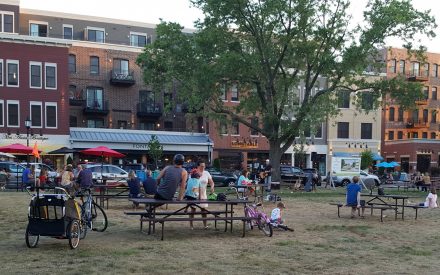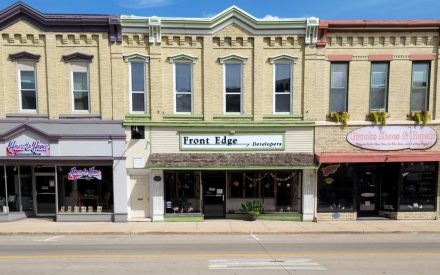
March 2022 — A niche is a specialization that allows a downtown to gain dominance in certain categories of retail and service businesses. Market analysis recommendations should include possible niche opportunities based on the data collected and analyzed throughout this study.
Successful communities often have two or three successful niches. These communities also benefit from an expanded trade area as their specialization often draws customers from more distant communities. Once a niche is established, other businesses are often attracted to the community as they are interested in selling to the same targeted consumer segments.
The following summarizes examples of consumer niches, many of which were drawn from a book titled Niche Strategies for Downtown Revitalization by N. David Milder and his PowerPoint presentation, Niche Revitalization Strategies, which updated the book.
Related Content
![]() Niche Revitalization Strategies (2007 update that expands previous book content), presentation format, N. David Milder, DANTH, Inc.
Niche Revitalization Strategies (2007 update that expands previous book content), presentation format, N. David Milder, DANTH, Inc.
Strengths, Weaknesses and Competitive Advantages
Since niche revitalization strategies aim at taking advantage of the skewed retail mix usually found in downtown areas, these districts, they are a better fit than strategies that aim at creating some optimal (and perhaps overly broad) retail mix.
A strong downtown niche provides consumers a large selection within a limited range of merchandise and services. Consequently, the shops in the niche constitute a specialized shopping center with the magnetism of a strong shopping destination. Strong downtown niches are known to draw many customers from beyond their traditional trade area.
The key to the strength of any retail niche is not the number of stores, but the amount of variety they can provide within the limited range of merchandise and services that defines the niche. Price variation also makes a niche more attractive. The home lighting niche on the Bowery in Manhattan has been around since the late 1960s and it draws shoppers from all over the New York metro area. Its history is instructive. By the mid-1980s it had grown enormously in its number of stores and the geographic area in which those shops were located. Currently, in 2022, there are a handful of lighting stores clustered in the same area.
A strong retail niche needs a location where it is very easy for shoppers to walk from one niche shop to another. This means that downtowns are often conducive locations for strong niches.
Downtown retail niches can last from just a few years to decades. Moreover, the erosion or disappearance of a previously strong niche may not signal downtown economic erosion, but that the niche has done its job and even stronger merchants are entering the downtown. For example, many retail niches will establish themselves in struggling downtowns and Main Street centers when rents for appropriate commercial spaces are very affordable. Often the success of these niches makes the downtown a much more attractive business location. The net result is increased demand for local retail spaces and increased rents. Many of the merchants in the niche that made the downtown an attractive business location may not be able to pay these rents.
Consumer Segment Niches
A niche can be based on a certain type of consumer who works, resides in, or visits your community. These consumers may demand a wide range of goods and services. Most downtown market analyses will identify consumer segment niches that potentially can be developed. However, the ability to realize these potentials depends on the presence of merchants who know how to market to specific consumer segments or are willing to pay to have it done for them.
Examples of these consumer-based niches include:
- College Students. Some communities with colleges and universities have successfully targeted the student population. Smaller towns and communities with commuter campuses tend to have more difficulty developing this niche. Most of the successful “College Town” retail clusters attract a mix dominated by eateries, watering holes, youthful and college related apparel, college bookstores and sometimes arts and crafts shops. The electronics and music shops they used to attract have been hit hard by the growth of e-commerce.
- Retirees. As the population ages and older Americans gain a larger share of savings and income, attracting retirees has become an economic development strategy for many communities. This sector of the population is expected to grow very significantly, but its too often overlooked heterogeneity makes marketing to it challenging.
- Ethnic Groups. Downtowns in larger cities are increasingly recognizing the tremendous retail demand created by inner-city consumers. Successful retailers in these communities realize differences in consumer preferences among and within specific ethnic groups. In response to these groups, specialized and powerful shopping districts can develop. Across the nation, many cities have Little Italys, Chinatowns, Korea Towns, Little Indias, Little Thailands, etc. Their power is dependent on their size, but more so on their uniqueness and authenticity. They can have impressive drawing power.
- Tourists and Travelers. Tourism has become a key strategy of big and small communities throughout the country. The influx of visitors provides demand for retail and entertainment, but also opens up opportunities for other alternatives in the downtowns including festivals, museums, lodging facilities and promotional events. Since tourism is usually seasonal, downtowns that have successful tourist niches have coped with the challenges posed by the “off-season.” Sometimes this includes the use of pop-up shops.
- Office Workers. While many downtown office workers prefer to make larger purchases at shopping centers close to their home, many specialty items such as cards, books, CDs, and some apparel are very convenient “lunch-time” purchases. Merchants targeting this market segment must recognize that office workers will 1) only walk about five minutes to lunchtime destinations, 2) spend far less than 60 minutes away from their desks, 3) be enticed by corporate cafeterias, subsidized meals and work pressures not to leave their buildings. Also, downtown office space occupancy has decreased in many communities, especially since the pandemic and its impact on remote work.
- Artists and Crafters. Many downtowns have recognized that local artists and crafters and those interested in their work provide a unique and active consumer segment to target. Communities serving this niche often have galleries, restaurants and bars, and unique specialty retailers. Their downtowns may include a mix of professional offices and business support services, such as copy shops and office supply stores. They also may have specialized operations such as foundries, arts supply shops, framing shops, arts conservationists, etc.
- County Government Users. In addition to attracting residents from throughout the county, county seats often attract lawyers, mortgage companies, title companies, public management consultants and others.
- Medical Facility Users. In addition to the visitation of patients and their families and friends, hospitals also attract visiting medical professionals. A mix of medical offices and retail businesses (drug stores, florists, medical supplies, etc.) are often found in these downtowns within 0.5 miles of a major hospital. Rochester, Minnesota, home of the Mayo Clinic, has a robust business mix that serves visitors and patients. Businesses include clothing, toy stores, gift shops, as well as service businesses such as fitness and wine and painting classes. The Rochester, Minnesota example is very interesting as the mix of businesses has remained stable over the years, and occupancy levels seem to be nearly 100 percent.
Mineral Point, Wisconsin has developed a niche focusing on tourists interested in the arts. The community has related businesses including pottery, woodworking, glass, jewelry and weaving studios. In addition, home-based artisans use this consumer niche to sell their products at existing downtown stores. The mix of businesses and historic charm of the community draws visitors as well as area residents to the downtown area. The local resident consumer segments are also served by traditional downtown retail including hardware, pharmacy and various merchandise categories. These businesses are able to survive thanks to a combination of local and tourist spending.
Goods and Services Niches
Some communities have developed a niche focusing on particular goods and services. Examples of niches based on categories of goods and services include:
- Home Furnishings. A cluster of related businesses may include home remodeling, furnishings and decorative design. Specific businesses might include hardware, floor covering, furniture, lighting, paint stores, frame shops, antique stores, window treatment stores, electronics stores, upholsterers, etc. Many of these businesses do not require large “class-A” spaces and look for affordable rents. Consequently, they often give downtown locations serious consideration.
- Pamper Niches. Spas, gyms, hair and nail salons, martial arts studios, etc. can bring a lot of patrons with significant disposable incomes and a proven willingness to spend it into a downtown shopping district. The activities in their windows – as opposed to those of professional services –often can provide pedestrian reinforcing eye appeal. Pamper niches have been mainstays of many well-known shopping districts, including Beverly Hills and Midtown Manhattan as well as many strong smaller downtowns. Other merchants would do well to cross-market with pamper niche operations.
- Antiques. Many small and medium sized communities have been successful in attracting numerous antique shops, often in a historic district. These businesses work well together in creating an historical, craft and hospitality theme and often create very effective niche marketing programs.
- Crafts. Some communities focus on craft-produced houseware items such as furniture, rugs, textiles, ceramics, and glassware. Critical to successful craft niches are strong downtown customer traffic, a mechanism to enable the crafters to sell in locations far away from the downtown and/or affordable high quality of life characteristics that make crafters want to live in or near the downtown.
- Children’s Products. Some downtowns are successful in this niche by combining stores focusing on children’s clothing, furniture, toys and family entertainment centers.
- Food-for-the Home. This is the most strategically important niche for most small and medium-sized downtowns. Shops in this niche generate more retail trips than any other. Consumers prefer to food shop close to home. Included in this niche are specialty foods such as bagels, breads, wines and cooking items. In some communities, this niche includes large grocery stores that serve as an anchor for downtown commercial activity. In others, a general store or gourmet food market are significant traffic generators.
- Jewelry. While many large cities have a jewelry district, some small towns have their own niche composed of jewelry retailers and service businesses.
- Entertainment and the Arts. Large and small cities across the country have improved downtown retail activity and public image by promoting the arts and entertainment. Formal entertainments, such as cinemas, theater, concerts, ballet, museums, art galleries, craft shops, and clubs all bring local and visitor spending downtown. Informal entertainments, such as those found in public spaces, are basically unscheduled, free and can generate very dense flows of patrons.
- Restaurants. This is another strategically important niche for downtowns of all sizes. Eating places can attract diners from trade area residents, tourists, and downtown employees. In many downtowns, restaurants have become the largest retail category, keeping these districts active well after 5:00 p.m. Savvy merchants will stay open to 7:00 or 8:00 p.m. to benefit from the customer traffic the eateries bring in.
- Weddings. Some downtowns serve the wedding market by offering jewelry shops, wedding attire, florists, caterers and other related businesses. Wedding niches can bring a hugely diverse group of businesses into a very successful marketing effort.
- Factory Outlets. A factory outlet is a store owned and operated by a manufacturer that sells its brand named merchandise at a discount. These stores are often clustered together to serve a “value retailing” niche.
|
Sheboygan Falls, Wisconsin is a successful Main Street community that identified, developed and promoted a distinct downtown niche. After doing a market analysis, local leaders better understood that this downtown’s retail strength was its growing cluster of home improvement businesses. It was already home to quality businesses selling furniture, paint, fixtures, wallpaper, kitchen supplies, antiques, outdoor home accessories, fireplaces, and more. The analysis of this home improvement cluster showed that these business were very complementary and shared many of the same customers in the county-wide trade area. Sheboygan Falls was establishing itself as the place to go for home improvement needs.The Sheboygan Falls Main Street program worked to capitalize on this existing niche with appropriate promotional events and targeted business development efforts. Main Street’s promotion committee developed a “Home and Hearth” retail event in the spring that promoted the downtown’s home improvement niche. This event included in-store demonstrations, sales, and prize giveaways. The event was successful in its debut, and has been a solid promotion for several years. Annually, the event garners nearly 100% participation from downtown home improvement businesses. Main Street’s Economic Restructuring Committee focuses its efforts on retaining and attracting businesses that strengthen the home improvement niche. The opening of Bemis Manufacturing’s retail outlet store in 1995 in a restored, historic building is one example of this targeted business development. This store’s merchandise includes home accessories and outdoor furniture. Downtown Sheboygan Falls’ niche continues to grow. |
Identifying Existing and Potential Niches
In many communities, niches already exist, but simply need to be organized. These niches can grow and become more visible through store expansion, recruitment of new businesses and cooperative advertising and promotion.
Using data from your market analysis, study the types of businesses that are currently located in your downtown to see how they fit together. The objective is to identify significant economic strengths in the downtown as evidenced by the number and square foot of complementary businesses, and the economic activity that draws people to these businesses. Once identified, the challenge then becomes organizing the businesses under a niche banner so that they can benefit from joint promotional and marketing efforts.
Once an existing niche is identified, the community should use it as part of its broad economic restructuring efforts. Cluster strategies (see Building Usage section) can be used to geographically define where businesses serving the niche should be located. A niche strategy should constantly evaluated and its economic impact quantified. Positive impacts on the economics of downtown should be widely reported and celebrated. This will serve to strengthen the niche.
Trying to create a new niche can be more challenging than trying to capture an existing niche. While new niches can be very successful, their development often involves risk and large investments from both the public and private sectors.
Sometimes, having one niche can be a base for developing another one, since the first already draws a certain type of customer. For example, a downtown with a restaurant niche may draw customers that might utilize entertainment or performing arts facilities.
Using data from your market analysis, analyze downtown and community characteristics to understand what types of offices, businesses or institutions are located nearby. Study niches in comparable communities. Recognize that a very different and expanded trade area could arise depending on the niche developed. Use your business owner and consumer survey findings to obtain ideas about possible niches.
Niche strategies that are based on either consumer groups or particular goods/services can help a downtown compete in the competitive retail environment. However, niches need to be carefully analyzed so that they are appropriate for a community. If done right, these strategies can lead to business expansion, new business development and significant increases in retail activity.
About the Toolbox and this Section
The 2022 update of the toolbox marks over two decades of change in our small city downtowns. It is designed to be a resource to help communities work with their Extension educator, consultant, or on their own to collect data, evaluate opportunities, and develop strategies to become a stronger economic and social center. It is a teaching tool to help build local capacity to make more informed decisions.
This free online resource has been developed and updated by over 100 university educators and graduate students from the University of Wisconsin – Madison, Division of Extension, the University of Minnesota Extension, the Ohio State University Extension, and Michigan State University – Extension. Other downtown and community development professionals have also contributed to its content.
The toolbox is aligned with the principles of the National Main Street Center. The Wisconsin Main Street Program was a key partner in the development of the initial release of the toolbox. One of the purposes of the toolbox has been to expand the examination of downtowns by involving university educators and researchers from a broad variety of perspectives.
The current contributors to each section are identified by name and email at the beginning of each section. For more information or to discuss a particular topic, contact us.












 Focus Group Analysis Tips
Focus Group Analysis Tips


